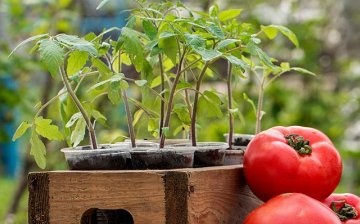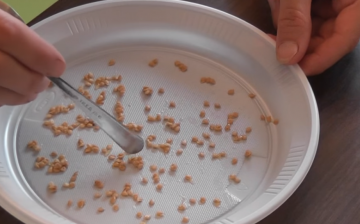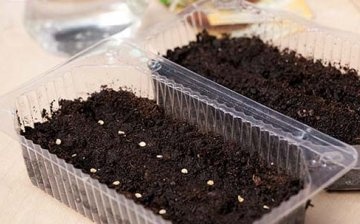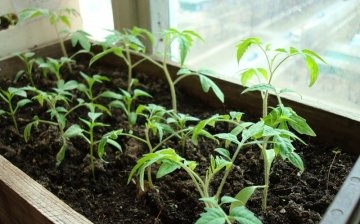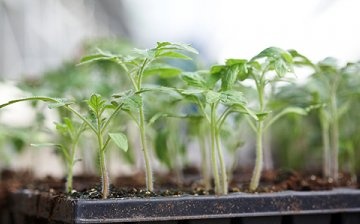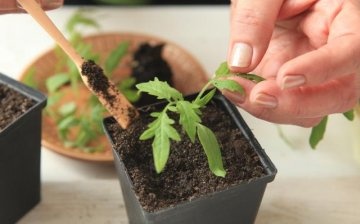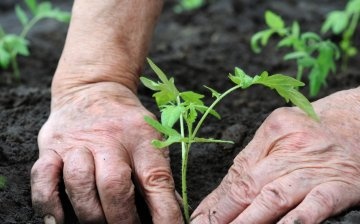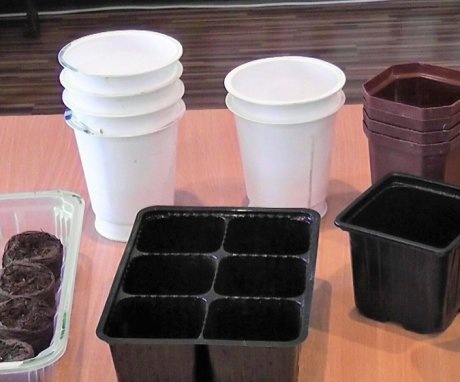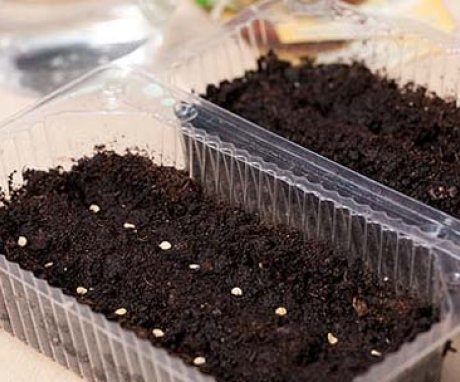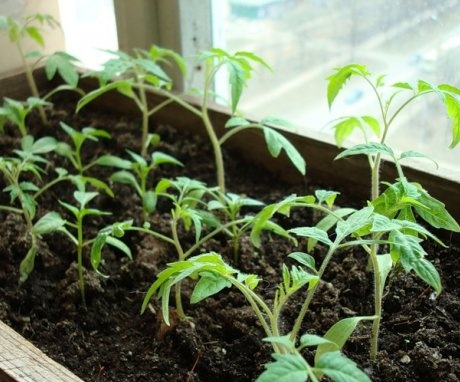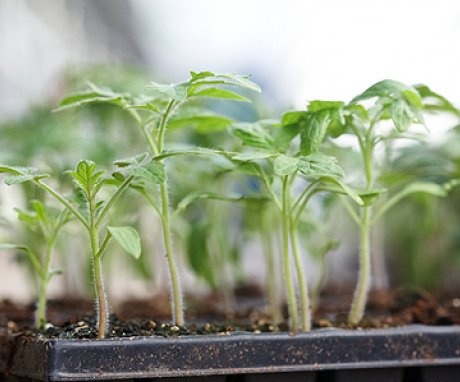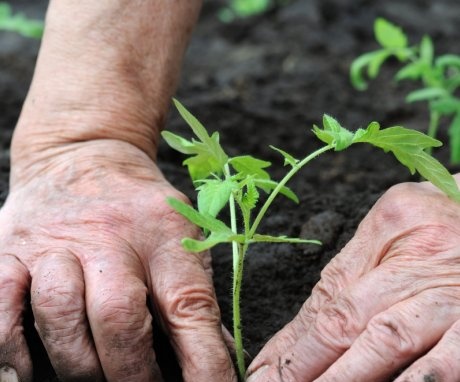Tips for gardeners: how to properly grow tomato seedlings
Tomatoes - a culture that no one refuses, they are eaten with bread, added to salads, soups, canned for the winter. Therefore, the use of red beauties in the kitchen is so rich and varied. To enjoy pickles in winter, they need to be prepared. And for this you need to grow tomatoes. This is not so difficult to do if you know the basic nuances of planting seeds for seedlings, and their further planting in open ground.
Content:
- Tomato soil and seed preparation
- Which container is better to choose?
- Planting seeds: terms and rules
- Growing conditions for seedlings: temperature, humidity and lighting
- Watering and feeding
- Dive or not?
- Transplanting seedlings into open ground: terms and rules
Tomato soil and seed preparation
To seed tomato, planted on seedlings, have sprung up safely, you should prepare not only high-quality planting material, but also a good substrate for germination. Tomatoes are quite capricious and not all soil will suit them. You need to take care of the nutritious soil from the fall. It should be saturated with minerals. It is in such a substrate that young tomato seedlings will successfully grow.
The best option for tomatoes is soil, in which 1 part is combined compost and humus. To saturate with nutrients, potassium sulfate, superphosphate and ash... You do not need to take too heavy soil, it should be airy, loose, with acidity at an optimal level, which allows moisture to pass through well.
Special attention should be paid to the seeds before sowing.
They are prepared a few days before disembarkation. On seedlings, various infections and fungal diseases can wait out the winter. They activate their activity together with the beginning of the growth of seedlings, preventing them from developing normally and bearing fruit. To eliminate diseased and empty seeds, they should be placed in ordinary water at room temperature. All that remains at the bottom is high-quality planting material, and it is recommended to throw out the emerging seedlings - they will not germinate.
After the sifted seeds should be treated with a special solution of potassium permanganate. The diluted liquid should be a deep purple tone. Seedlings should be placed in the solution for 25 minutes. The last stage of preparation is soaking in water for 10 hours to swell the planting material. After that, you can start planting in containers for germinating seedlings.
Which container is better to choose?
While the seeds are going through the process of preparing for planting, it is recommended to start selecting a container. For planting, you can use both medium and large containers.
If a large pot is chosen, then many seedlings can fit in it at once. If landing in the middle container is decided, then the procedure is possible picks will not be needed.
You can take a low wooden box, no more than 10 cm high.
It is convenient to place seedlings in it. The grown plants will grow comfortably. Upon reaching 7-10 cm, mature seedlings can be ripely dived into a larger container.
In the case when small pots or plastic cups are selected, sold in each store, then the planting material will not need to be transported to another pot. The sprouts, upon reaching the optimal size, are transplanted to a permanent habitat. The main thing is to make holes at the bottom of the glasses for excess liquid to drain out after watering.
Feasibility of planting in separate glasses:
- Helps to avoid all seedlings of mass diseases (black leg).
- Each seedling receives the same amount of nutrients.
- When transplanting, the plant is not injured.
Before sowing, the prepared container should be thoroughly washed with soap and water, and then the walls should be rinsed with boiling water. Check for drain holes. If they are not there, then you need to do them with a knitting needle, nail or screwdriver.
Planting seeds: terms and rules
Tomatoes - a culture rich in various varieties. They should not be planted all at the same time, but at certain times that are optimal for planting one or another type of tomato.
There are approximate periods for sowing in central Russia:
- Early varieties for planting in a container - March 20 - April 5.
- Early varieties for greenhouse cultivation - March 15-20.
- Late varieties - inappropriate breeding.
The latter species is most often not planted in open ground, due to the fact that it does not have time to mature in time. These varieties are most often grown in specially prepared greenhouses with lamps. artificial lighting.
Sowing tomatoes in the southern regions has its own terms:
- Hybrids and early species - from February 20 to March 5.
- Mid-season varieties - from March 1, but no later than April 1.
- Late ones - are planted together with medium species or in warm windows from March 20 to April 20. Most often, these varieties are planted directly into the ground.
Planting a tomato is not particularly difficult. In the container, the soil should be leveled so that it is evenly distributed throughout the container. With a ruler or improvised means, grooves are made with a depth of no more than 1-1.5 cm. Each of the grooves should be drawn no closer than 2 cm from each other.
Seeds are laid out along the groove. The larger the seed, the further the distance should be between them. If there is too dense germination, the sprouts will appear in the seed coat. You cannot remove it yourself. To exfoliate it, carefully place 1 drop of warm water from a pipette onto the head. After that, the shell will fall off by itself.
If sowing is supposed to be in small cups, then the soil is laid in a container for 2/3 of the volume.
Then 2-3 seeds are placed once. This is necessary to support each other as they grow. The latter is to sprinkle with soil on top, about 1-2 cm, while lightly press down on top. Thus, any beginner will cope with planting a tomato with knowledge of the technique. The main thing is that there is a desire to grow ripe beauties.
Growing conditions for seedlings: temperature, humidity and lighting
After sowing, containers with seedlings are covered with foil and transferred to a warm, sunny place. The optimum temperature for germination is +25 C. At this temperature, young sprouts can please with their appearance as early as 5-7 days. When the first shoots appear, the film is immediately removed. This is necessary so that high humidity does not provoke rotting of young stems.
Be sure to monitor the humidity.
It should not dry out, but the earth should not turn into a swamp. If the young growth that has emerged began to sprout during the spring frost, then the flowerpot should be placed on the windowsill, placing it on a foam pallet.
So that the seedlings do not stretch too much, striving for light, they are supplemented. Either special phytolamps or LED table lamps are used. Such measures are of great importance on cloudy days. In addition, it is necessary to carefully monitor the moisture that accumulates in the pan after watering.It should be removed - it can cause decay root system and the death of a seedling.
Watering and feeding
Watering is carried out both before planting (it is necessary to wet the prepared soil well the day before sowing), and after planting germinated seeds... After irrigation of the substrate, watering is not performed until the first shoots appear. The optimal temperature and humidity inside the mini-greenhouse will provide favorable conditions for growth. At the time of mass growth, when loops appear, irrigation is carried out only from a spray bottle and in moderate quantities. Otherwise, small roots can be washed out of the soil with a large jet.
Before the appearance of the first real 2 leaves, watering is carried out only as needed, as well as when the soil is very dry.
When moistening, they try to pour water between the rows so as not to get on the delicate leaves and stems of the tomato. When 2-3 leaves grow back, they produce pick... Before the start of the event, they are well watered so that the earth is saturated with moisture, it was easy to remove the seedlings for picking. It is not recommended to water for 4-5 days after the transshipment procedure. This will complicate the adaptation process. Further, watering is normalized depending on the drying out of the soil. Melt or rain water is recommended. Usually it is not there, so they use tap water. To soften it, you need to boil and defend. The best temperature for watering is + 20 + 23 C.
Additional feeding produced only if the plant looks painful - the stem is thin, the foliage becomes yellow. In this case, fertilization is necessary, as well as mulching of the soil under the seedling with fine dry river sand. For fertilization, folk remedies are used in the form of an infusion of nettle, iodine, eggshell, yeast and wood ash.
For foliar dressing, use solutions:
- Urea
- Potassium monophosphate
- Fitosporin
- Potassium nitrate
- Superphosphate
Each of the solutions is formed in a ratio of 1 tbsp. for 10 liters of water. Foliar dressing is carried out by spraying mineral fertilizers or dilution of a solution from chicken droppings... When using a ready-made additive, take 1 tsp. for 5 liters of water (warm), the same parameters are suitable for organic dressings.
Dive or not?
A dive is required if the seeds have been planted tightly in a large container. You can dive sprouts at the time of the formed 2 leaves. This period usually occurs 3 weeks after the first shoots appear. A pick can be carried out not for all seedlings, but only for parts of it, thereby discharging crowded rows, planting seedlings that interfere with the development of other sprouts.
In order for this process to proceed safely, the temperature of the earth in the container must warm up to + 14 + 18 C. It is desirable that the air be +23 C, and the night temperature does not fall below +14 C.
You can plant seedlings both in separate pots and in a greenhouse.
During transplantation, you need to bury the stem completely to the cotyledon leaves. This is necessary for additional roots to form on the stem. This will strengthen and expand the root system. Diving promotes the growth of seedlings stronger and stronger, and also differs in the quality of the crop - by increased rates.
Before diving, the ground should be well shed. When removing a seedling, you need to do this carefully and slowly, you need to try not to damage either the roots or the stem. Then you need to pinch off the top at the main root, removing it by 1/3 of the total length. After that, be sure to water.
Transplanting seedlings into open ground: terms and rules
Before planting for permanent residence of handsome red men, their height should be up to 35 cm in height, they must necessarily have at least 7 full-fledged leaves and a powerful stem.
Preplant Tips:
- They are planted in open ground, when the spring frosts have long passed.They should be planted so that only 4 bushes are located per 1 m2.
- It is advisable to put several pest control granules in each hole (bear), as well as pickled grains from the Colorado potato beetle.
- They are planted in a permanent place in mid-late May, depending on the variety. There is no need to wait for the plant to acquire a gorgeous crown - this will cause an even longer adaptation.
- The holes are dug 25 cm deep, they spill well.
- The seedlings are planted vertically, completely deepening the entire stem, down to the lower leaves.
- If the plant is very tall, then the hole is made deeper, but the stem is not completely buried in. They fall asleep after the young bush rises.
- Watering the bush is not required for the next 7-10 days. There is enough moisture in the ground to feed the roots. But if the weather is hot, then it is necessary to water earlier, otherwise you can lose all the seedlings.
Thus, growing tomatoes is easy if you take into account the correct planting of seeds in the container, as well as competent picking and planting in the soil.
More information can be found in the video:



